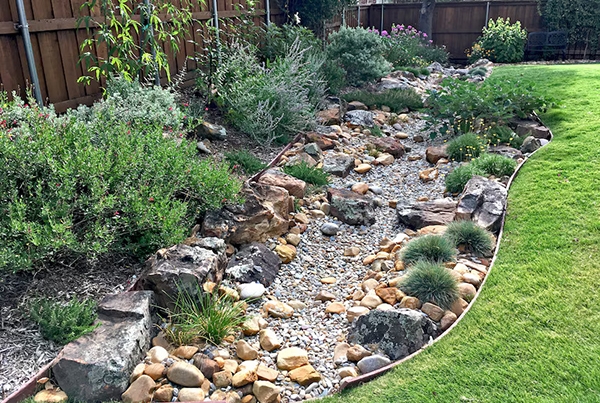Rockscapes, also known commly as rock gardens, are becoming more and more popular in the Pacific Northwest. Popular for decades in hot and arid states like Southern California, Nevada, Arizona and New Mexico where water hungry lawns are not practical, Rockscaping allows almost endless possibilities. Because of its non-organic nature, rock doesn’t decompose like beauty bark, so a properly installed rockscape feature will last for years and years, relatively trouble free.
The most important initial part of any rockscape idea is the initial plan. The conceptual plan will determine the materials needed. The chosen location will determine the amount of work involved to construct it. The size of the feature will determine the amount of materials needed. Rockscapes can range from incredibly simple use of rock around trees and shrubs to more elaborate landscape rockscape features.
One very popular trend in the past several years in Washington State are rain gardens that are designed to disguise rainwater runoff from the house or yard. Rain gardens are often influenced by nature, where the use of rock and native plants are designed to resemble streams or rivers. Other examples of popular features are dry creeks, which are again often designed to resemble natural creeks or streams but without the water runoff.
Rockscape is often used as a landscape feature, such as near front entrances or at the edge of driveways. Even relatively small but tasteful rockscape feature in the right location can make a large impact on your yard.
Common rockscape materials
Washed crushed rock - rock material crushed to a specific size, such as ¾”, 1 ¼” or 3”. Crushed rock has irregular edges and shapes and is often used in rockscapes as a base course. It is also popular in simple rockscape ground covers such as trees and shrubs.
River rock - rock material of various sizes, usually smooth with rounded edges as often found along river beds.
Cobbles - rock material of various sizes ranging from 2”-10”, usually with rounded edges. Often used as accent stones around edges of rockscapes.
Boulders – Larger native stones of various sizes, can have rounded or irregular edges. Often used as accent stones in rockscapes.
Peagravel – smaller diameter washed rock, often ranging from ¼” – 3/8” in diameter. Peagravel is often used as a base course. Peagravel has a soft slushy feel under the feet and is often used as a ground cover for front entrances, walk paths and entertainment areas.
Other materials – Other materials are sometimes used as accent materials for rockscape, such as larger pieces of driftwood, sometimes yard art is utilized.
Graystone Tractor Services offers Gravel and rock services which can help you construct a rockscape or rock garden in your yard. Call / text us at (360) 542-6460 or fill out our free estimate request form.


